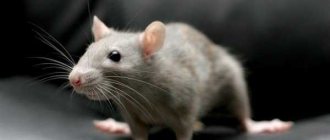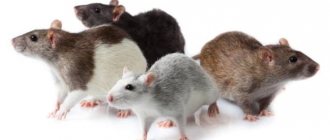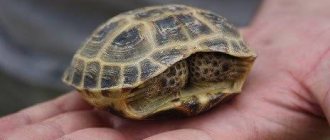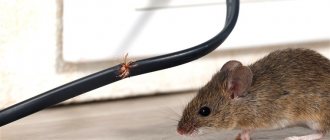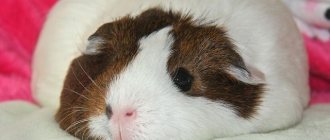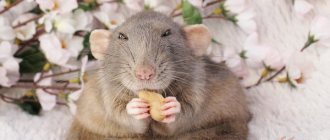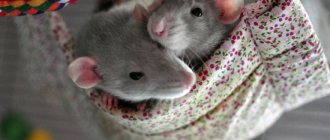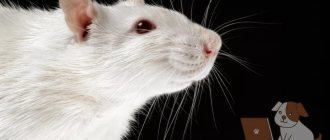How to determine the sex of a decorative rat. What are the differences between females and males. The main differences are in the appearance of decorative rodents. Are there any differences in the behavior and character of the pets? Where is the best place to buy an animal? What you need to know about maintenance and care. Tips and recommendations for owners.
When we want to buy a decorative rat, we try to think through everything down to the smallest detail, where the pet will live, what items it will need, what to name it, how to feed it properly. In addition, everyone has their own preferences regarding the breed and gender of the animal.
After all, females and males differ in character and behavior. In addition, there are many situations when it may be necessary to understand and determine the sex of an animal. Next, we will take a closer look at how to determine the sex of a rat and learn about all the differences and characteristics of boys and girls.
What are the differences between the sexes?
So, the most important difference between an adult male and a female is, of course, the presence of testicles. They are located directly under the animal's tail. They are easy enough to see, but can also be felt with your finger.
But it should be remembered that if you lift the tail, they move inside the tummy and it becomes very difficult to notice them externally; they can also move at low temperatures. Therefore, in such cases, you can easily confuse the gender. During inspection, the tail should not be raised; it should be kept down.
Females have mammary glands, which are located in 2 rows; in boys, they do not appear at all. There is also a difference in the distance between the anus and the urethra. If in girls they are located close to each other and are at a distance of 2-3 mm, then in boys this distance is 5-6 mm.
Remember that when examining a pet, you should not squeeze it tightly, hold it by the tail, or make sudden movements. They are very shy and this can cause stress. Hold it carefully, you can try placing it on your palm with its back. The differences apply to all breeds, Dumbo and others. Photos will help with the correct definition.
Description[edit | edit code]
Small long-tailed rodent: body length from 6.5 to 9.5 cm. The tail makes up at least 60% of the body length, covered with horny scales arranged in a ring shape and sparse short hairs. Weight - 12-30 g. Ears are round and small. The skin is dark or brownish-gray; belly - from ash-gray to white. Desert mice have a light, yellowish-sandy color and a white belly. Among the domesticated ones there are white, black, yellow, gray-blue and variegated individuals. Females have 5 pairs of nipples. Sexual dimorphism is weakly expressed.
How to choose a pet?
First of all, it should be said that the place where the animal is purchased is very important. It is not recommended to purchase a rodent by hand if there is no way to check the conditions in which it is kept. Because there is a high probability that a sick or old animal may be sold to you.
It is better to buy a rat from trusted breeders or from a pet store. Breeders, as a rule, pay great attention to proper maintenance, care and feeding. They can tell you about the rat’s parents, characteristics of the breed, character, behavior, and give recommendations regarding further maintenance.
It is necessary to examine the animal; a healthy individual always has very beautiful and shiny fur, without any bald spots. The ears and eyes must be clean and free of any discharge. If there are other rodents in the cage, pay attention to them; they should also have a healthy appearance.
Animals should be active and mobile; if they are very calm, sit in one place and do not react to humans, this may indicate illness. Also, you should not choose highly excited individuals. On average, decorative pet rats live 2-2.5 years, but this period can be increased if the animal is provided with proper care and adequate nutrition.
How else can you tell the difference between a female and a male? Indirect signs
In addition to differences in reproductive organs, male and female rats typically differ in body size and type, behavior, smell, and other factors.
In general, males are larger, wider and heavier, with thicker tails and coarser coats. They have broad heads and shoulders that have a “brick” shape.
Females are more graceful, meaning they have a narrower, more streamlined shape with shorter, shinier coats. They are usually smaller and lighter, but a small boy can be significantly smaller than a large girl.
However, some pet rats can weigh even more than this.
Most female rats prefer to move around a lot rather than sit still, but not all male rats share this trait.
Male rats can certainly be calm and relaxed, but that doesn't make them lazy. Almost all rats, given a lot of attention from birth, will enjoy time with their people and the touch we often want to share with them.
Women's hormonal cycles can sometimes affect their behavior, making them more restless and even irritable. However, many females show almost no signs of estrus and yet remain alert.
Menopause in females occurs between 15 and 18 months, although some females remain fertile into old age. Males are capable of constantly reproducing offspring until old age. They do not have a reproductive cycle, but their testosterone levels fluctuate greatly.
Sex hormones are also associated with the slightly musky odor that many males have (not heavy or unpleasant). People often describe their female rats as smelling like grapes, perfume, or even popcorn. This is the smell of the rats themselves, not their cage - most likely it is the smell of urine or feces.
We believe that all rats make wonderful pets, regardless of whether they are male or female. However, most people will develop a strong preference for one gender over the other, and this is completely normal.
We humans are individuals too, and we all look for different traits and characteristics in the animals we choose as pets. So, regardless of gender, your rats can be active, interesting and affectionate companions.
Source
Sex determination in small rodents
First of all, it should be noted that the first sexual differences in small animals appear on the 4th-5th day of life. The task of identification will be facilitated by the fact that animals at this age do not have fur, so just look at the tummy. Girls will have noticeable small nipples, they are arranged in two rows. In boys, they are absent throughout their lives.
You can also pay attention to the skin between the anus and urethra. If small dark spots are observed, this is a male specimen. Such spots are future testicles; they are not yet visible because they are in the process of formation.
A little history
Cute, affectionate and tame decorative rats are descended from ordinary wild gray rats, which cause a feeling of disgust in humans, as well as a certain fear. This is not at all surprising, since wild rats have gained notoriety not only for their behavior, but also for their ability to spread various viruses and infections.
The Chinese and Indians first became aware of wild rats several thousand years ago. In the 16th century, as maritime trade developed, rats spread throughout the world, moving from continent to continent. In the 19th century in England, these rodents began to be used in battles against dogs, after catching them. During the same period, some hobbyists began breeding rats, especially tame, white ones. Such tame rodents were shown at exhibitions; in addition, white rats took part in circus performances. Some pet lovers started keeping rodents in their homes because they did not pose any danger to humans.
Some of the individuals were used as experimental animals in various laboratories, which is still practiced today, and some of them moved into the homes of scientists. Scientists saw in rats animals that are quite intelligent and attached to humans. Thanks to the crossing of laboratory rats with wild animals, new species and breeds of domestic decorative rodents have appeared, which can still be found among various breeders.
Differences in appearance and personality
In addition to physiological ones, there are differences in the behavior and character of the animals. In addition, you can find differences in the external characteristics of pets.
Let's look at them in more detail:
- Boys are always larger than girls, they have a stronger and more powerful physique, but it will be difficult to notice this at an early age.
- Girls boast very graceful body shapes, while boys have a pear-shaped body.
- There are also differences in the coat; in males the fur is quite dense and hard, while in females it is very soft, smooth and silky.
- Females are very inquisitive, they are interested in everything and want to examine all the objects around them, in addition, they are very willing to try them out. But males, on the contrary, spend more time in peace, like to hide in a house, and also don’t mind sleeping more.
- No matter how strange it may sound, females are more aggressive than males. This is not due to a difficult character or complex disposition. It is their nature to protect their offspring, so when frightened they are capable of scratching and even biting.
- Males have a stronger smell of urine, but if you keep your pets properly and carry out regular cleaning, this is not so noticeable.\
Experienced breeders recommend purchasing two animals at once, especially in cases where the owners do not have enough free time. This will prevent the animals from getting bored, and they have a very hard time withstanding loneliness.
But to keep two rodents in one cage, it is necessary to purchase girls. They get along well with each other, while males can fight over food and territory.
Before buying a pet, it is important to weigh all the advantages and disadvantages so that there are no difficulties later.
What kind of domestic rodents exist: list of species, how long do they live at home?
Pet rodents
Pet rodents are deservedly popular. Small furry animals are funny, cute and relatively unpretentious - they are easier and more economical to keep than a cat or dog. There are several types of rodents that are suitable for living at home. Here is the list:
- Common hamsters
- Djungarian hamsters
- Guinea pigs
- Decorative rabbits
- Chinchillas
- Gerbils
- Rats, etc.
Decorative rats occupy not the last place among pet rodents. They are distinguished by intelligence, affection and learning ability, as well as greater cleanliness than is commonly thought.
Difficulties in keeping rodents can arise due to their need to sharpen their teeth. Rodents are rodents: they love to taste everything, even wires. Disadvantages include the low life expectancy of animals at home. If guinea pigs can live 6-8 years , then rabbits and chinchillas can up to 15 years . The lifespan of other small rodents is about 3 years . This also applies to decorative rats. When choosing a pet (especially for a child), you need to keep this in mind to avoid future stress.
Important content points
If the owner devotes time to proper maintenance, care and nutrition, he will prolong the life of his pet. It is necessary to properly arrange the animal's cage, equip it with shelves, ladders, tunnels, hammocks, and houses.
Physical activity is very important for a rat's health. In addition, remember that these rodents are social animals and need care and attention.
Be sure to regularly clean the cage, monitor the condition of the claws, teeth, ears, and tail. They are very clean animals and do not need help from people, but sometimes it may be required.
Examine the animal and monitor its well-being. If you notice changes in behavior, loss of appetite, discharge from the nose, eyes, or any other symptoms that look different than usual, contact your doctor immediately. All diseases are treatable if they are diagnosed in the early stages.
Creative English nicknames
English names are also at the peak of popularity. They are always in fashion. Both classic and extraordinary.
An interesting selection of creative names for Dumbo rats:
- Slang;
- Respect;
- Like;
- Dig;
- Little;
- Follower;
- Burger;
- Dir;
- Fluffy;
- Slot;
- Prank;
- National;
- Job;
- Stroppy;
- Proof;
- Chica;
- Dodge;
- Let's Go;
- Agri;
- Bestie;
- Crush;
- Rofl;
- Skill;
- Stream;
- Fakap;
- Mate.
Rat care
Caring for a pet rat is not difficult and comes down to caring for the animal and its health, which is impossible without a clean home for the animal, without a balanced diet and the availability of clean water to drink. In addition, the rat owner needs to know:
- The cage with the animal should be placed in a dry, warm place, and the cage should not be exposed to direct sunlight or drafts.
- The cage requires daily cleaning, removing food debris and litter, as well as washing the feeder and drinking bowl.
- A couple of times a week it is necessary to disinfect the cage using disinfectant solutions.
- From time to time you should trim the animal's claws using nail scissors or clippers.
Feeding rats
Domestic rodents are absolutely unpretentious in food, although each rodent has its own gastronomic preferences. It is very important that the diet is balanced, otherwise problems with the digestive system may occur, which can lead to obesity. Therefore, the diet of rats should consist of the following foods:
Cereals
For feeding, both dry cereals and boiled porridges based on buckwheat, corn, barley, rice and wheat are used.
Seeds and nuts
Rodents will eat flax, pumpkin and sunflower seeds, nuts, and various greens with appetite. Sprouted millet, oats and wheat can be used as vitamin supplements.
Dairy products
Pets will be very happy to eat kefir, cottage cheese, fermented baked milk, yogurt, which are rich in calcium and bacteria for the normal functioning of the digestive tract.
Protein and meat
Food sources such as boiled eggs, meat, fish, liver, kidneys and heart will serve as a source of protein food.
Vegetables
How could we live without vegetables and fruits, a source of fiber, vitamins and microelements, which have a positive effect on the functioning of all internal organs.
Clean drinking water and treats
Treats for domestic rats include apple slices, carrots, watermelon, puffed rice, corn, strawberries, and grapes.
Features of birth
After the baby is 3–3.5 weeks old, the owner can pick him up. Rodent breeders note that the more often you hold them in your arms, the more affectionate and obedient they will become. The key is to not overdo it. You need to know when to stop everything. Excessive affection is a factor in the development of stress in a pet. You should not separate the mother from the babies for a month. The immune system of newborn rat pups is directly dependent on how long they will be around it.
The total growth period for rat pups is one year. As for nutritional features, after a month you can add cottage cheese, boiled chicken bones, apples, milk corn, and bananas to their diet. There are also a number of foods that should not be included in the diet of baby rats. These are yolk, broccoli, salads, cucumber, liver, tomatoes.
Experts in breeding animals of the rodent family advise adhering to the above recommendations at least until the baby rats reach three months.
The small animal is a defenseless creature that needs special careful care and maternal attention. The attitude of owners towards an animal should be the same as towards their child.
Development of baby rats by day
Newborn rodents grow very quickly, a defenseless blind lump becomes an adult after 4 weeks, males reach sexual maturity at 5, and females at 6 weeks. The development of rat pups day by day is as follows:
1st day
Immediately after birth, the pups are naked, pink, blind and deaf babies with underdeveloped limbs and a small tail, who can only squeak, suck and sleep.
3-4th day
The cubs' ears open, and now the pups can distinguish not only smells, but also sounds.
5-6th day
The bodies of newborns begin to be covered with the first soft hair, the skin has become flesh-colored with dark spots, the presence of which determines the color of rodents.
8-10th day
The baby rats are erupting their first teeth, the babies are already covered with short velor fur, the cubs are becoming very nimble, they start fights over the mother’s nipple, their movements are not yet fully coordinated.
12-13th day
The babies' eyes open, the pups explore the territory, actively try to get out of the nest, but the rat diligently returns the children to their original place.
14-16th day
At this time, secondary sexual characteristics are formed and the sex of the animals can be determined; in females, nipples are visible on the abdomen.
